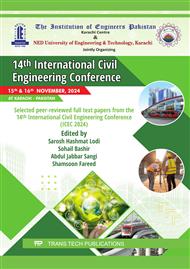[1]
A. Khitab, M. Alam, H. Riaz, S. Rauf, Smart Concretes: Review, Int. J. Adv. Life Sci. Technol. 1 (2014) 47–53.
DOI: 10.18488/journal.72/2014.1.2/72.2.47.53
Google Scholar
[2]
A. Khitab, W. Anwar, Classical Building Materials, in: 2016: p.1–27.
DOI: 10.4018/978-1-5225-0344-6.ch001
Google Scholar
[3]
A. Al-Fakih, B.S. Mohammed, M.S. Liew, On rubberized engineered cementitious composites (R-ECC): A review of the constituent material, Case Stud. Constr. Mater. 14 (2021) e00536.
DOI: 10.1016/j.cscm.2021.e00536
Google Scholar
[4]
N.M. Saeed, H.Z. Hassan, An overview of fresh and mechanical properties of rubberized concrete, Discov. Civ. Eng. 1 (2024) 14.
DOI: 10.1007/s44290-024-00016-8
Google Scholar
[5]
A.M. Mhaya, S. Baharom, G. Fahim Huseien, Improved strength performance of rubberized Concrete: Role of ground blast furnace slag and waste glass bottle nanoparticles amalgamation, Constr. Build. Mater. 342 (2022) 128073.
DOI: 10.1016/j.conbuildmat.2022.128073
Google Scholar
[6]
A.A.M. Fadiel, T. Abu-Lebdeh, I.S. Munteanu, E. Niculae, F.I.T. Petrescu, Mechanical Properties of Rubberized Concrete at Elevated Temperatures, J. Compos. Sci. 7 (2023) 283.
DOI: 10.3390/jcs7070283
Google Scholar
[7]
S. Sun, X. Han, A. Chen, Q. Zhang, Z. Wang, K. Li, Experimental Analysis and Evaluation of the Compressive Strength of Rubberized Concrete During Freeze–Thaw Cycles, Int. J. Concr. Struct. Mater. 17 (2023) 28.
DOI: 10.1186/s40069-023-00592-6
Google Scholar
[8]
L.-Y. Feng, A.-J. Chen, H.-D. Liu, Effect of Waste Tire Rubber Particles on Concrete Abrasion Resistance Under High-Speed Water Flow, Int. J. Concr. Struct. Mater. 15 (2021) 37.
DOI: 10.1186/s40069-021-00475-8
Google Scholar
[9]
E. Eltayeb, X. Ma, Y. Zhuge, J. Xiao, O. Youssf, Dynamic performance of rubberised concrete and its structural applications – An overview, Eng. Struct. 234 (2021) 111990.
DOI: 10.1016/j.engstruct.2021.111990
Google Scholar
[10]
R.B.N. Khan, A. Khitab, Enhancing Physical, Mechanical and Thermal Properties of Rubberized Concrete, Eng. Technol. Q. Rev. 3 (2020) 33–45.
Google Scholar
[11]
A. Khitab, R.B.N. Khan, Suitability of concrete incorporated with scrubbed rubber tire particles: Assessment based on destructive and non-destructive testing, Pakistan J. Eng. 1 (2022) 6–22.
Google Scholar
[12]
M. Sattar, R.B.N. Khan, A. Khitab, Performance Evaluation of Ordinary Concrete having Crumb Rubber Treated with Alkaline Solution, Tech. Journal, UET Taxila. 3 (2024) 8–13.
Google Scholar
[13]
ASTM C305, Standard Practice for Mechanical Mixing of Hydraulic Cement Pastes and Mortars of Plastic Consistency, West Conshohocken, PA, 19428-2959 USA, 2022.
DOI: 10.1520/c0305-99
Google Scholar
[14]
ASTM C188-17, Standard Test Method for Density of Hydraulic Cement, West Conshohocken, PA, 19428-2959 USA, 2023.
Google Scholar
[15]
ASTM C1437-20, Standard Test Method for Flow of Hydraulic Cement Mortar, West Conshohocken, PA, 19428-2959 USA, 2020.
Google Scholar
[16]
ASTM C1314-21, Standard Test Method for Compressive Strength of Masonry Prisms, West Conshohocken, PA, 19428-2959 USA, 2021.
Google Scholar
[17]
ASTM C143/C143M-20, Standard Test Method for Slump of Hydraulic-Cement Concrete, West Conshohocken, PA, 19428-2959 USA, 2020.
Google Scholar
[18]
ASTM C642-21, Standard Test Method for Density, Absorption, and Voids in Hardened Concrete, West Conshohocken, PA, 19428-2959 USA, 2021.
DOI: 10.1520/C0642-21
Google Scholar
[19]
M. Al-Gburi, S.A. Yusuf, Investigation of the effect of mineral additives on concrete strength using ANN, Asian J. Civ. Eng. 23 (2022) 405–414.
DOI: 10.1007/s42107-022-00431-1
Google Scholar
[20]
M.T. Arshad, S. Ahmad, A. Khitab, A. Hanif, Synergistic Use of Fly Ash and Silica Fume to Produce High-Strength Self-Compacting Cementitious Composites, Crystals. 11 (2021) 915.
DOI: 10.3390/cryst11080915
Google Scholar
[21]
A. Khitab, S. Ahmad, R.A. Khan, M.T. Arshad, W. Anwar, J. Tariq, A.S.R. Khan, R.B.N. Khan, A. Jalil, Z. Tariq, Production of Biochar and Its Potential Application in Cementitious Composites, Crystals. 11 (2021) 527.
DOI: 10.3390/cryst11050527
Google Scholar


